Jun 20th 2019
Driving With Dogs 101: How to Keep Your Dog Safe and Happy in the Car
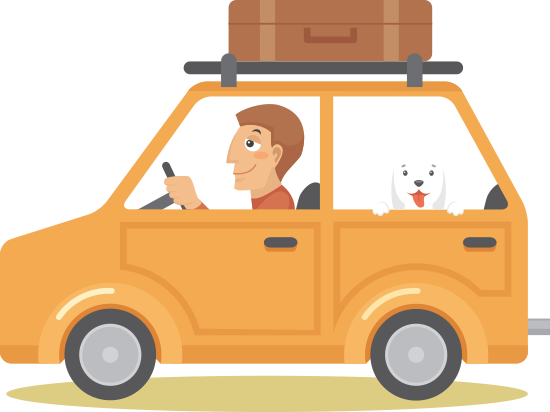 As the summer months come upon us the road beckons to be traveled. Our friend Carmen Adams from South Dakota State University has put together some great tips to keep in mind when travelling with your dog. Despite the number of car commercials starring an obedient, window-gazing pup, driving with dogs is a serious source of anxiety for many pet owners. Dogs are naturally enthusiastic, active, and curious: traits that are likely to intensify when transferred to a moving, bumpy vehicle. Ideally, driving with your dog provides an opportunity to bond and explore - or to simply accomplish chores without leaving a squirrelly pup home alone. Whatever your reasons, the following ideas prioritize the safety of both you and your dog as you travel to your next destination.
As the summer months come upon us the road beckons to be traveled. Our friend Carmen Adams from South Dakota State University has put together some great tips to keep in mind when travelling with your dog. Despite the number of car commercials starring an obedient, window-gazing pup, driving with dogs is a serious source of anxiety for many pet owners. Dogs are naturally enthusiastic, active, and curious: traits that are likely to intensify when transferred to a moving, bumpy vehicle. Ideally, driving with your dog provides an opportunity to bond and explore - or to simply accomplish chores without leaving a squirrelly pup home alone. Whatever your reasons, the following ideas prioritize the safety of both you and your dog as you travel to your next destination.
Common Types of Car Restraints for Dogs:
ANXIOUS DOG:
MOBILE PET BED OR CARRIER
This product provides a comfortable, protected space for smaller dogs who are less enthusiastic about car rides. To lessen their nerves, you can even provide with your dog with a distracting toy or a clothing item from home with a familiar smell.
Take note: The “Sleepypod” Pet Bed is the only mobile carrier that is safety-certified by the Center for Pet Safety. In general, mobile beds and carriers are well-suited for trips to the vet’s office or other unfamiliar places, and usually have a shoulder strap to help you transport your pup in and out of the car.
To use: Place your dog inside, wrap the seat belt around the base of the bed, and pull the shoulder belt through the top handle. Some beds include a small D-ring inside, which can be secured to your dog’s collar with a short tether.
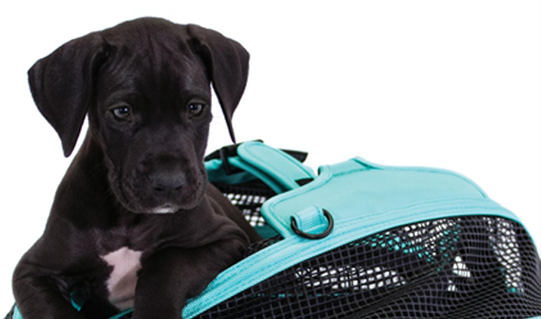
![]()
FOR AN OLDER DOG: CAR HAMMOCK
While car hammocks do not provide as much security as other restraints, they are ideal for older, calmer dogs and shorter car trips.
Take note: You may want to purchase a lift harness to help an older dog into the car, particularly if their mobility or vision is impaired. Also look for non-slip, waterproof hammocks with durable fabric.
To use: Place the hammock on your backseat with the plush side up. Attach the adjustable straps around the front and rear headrests. Insert the handles in between the surface and the back of the seat to secure the hammock.
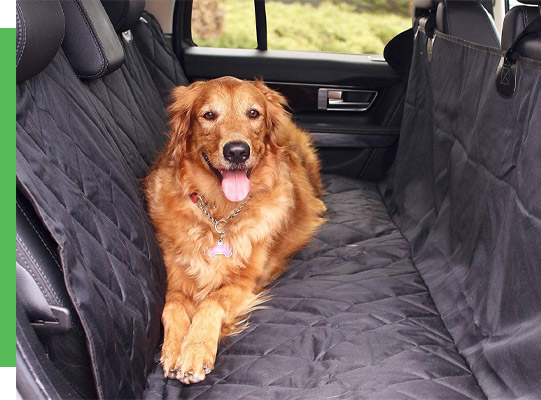
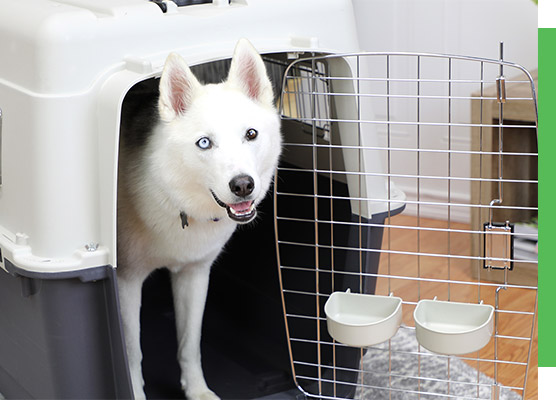
![]()
FOR BIGGER DOGS: TRAVEL CRATES
Big dogs are great for cuddles and outdoor adventures, but finding them appropriate car restraints can pose an equally large challenge. Thankfully, a sturdy travel crate ensures both the safety and comfort of your big dog. Regardless of size, the dogs best-suited for crates are calm, confident car passengers who don’t require constant reassurance from their owners.
Take note: If you are placing your dog in the cargo area, check with your car manufacturer to confirm that this is not the crumple zone of your vehicle. To use: Find the appropriately sized crate for your pup (smaller sizes are available!). Secure the crate in the boot or the backseat, depending on which is safest. Most vehicles have D-rings that can be used to tether your dog’s crate on both sides.
![]()
FOR ALL DOGS: TRAVEL HARNESS
Travel harnesses are one of the easiest and most popular car restraints for dogs. They can be used both in the car and as a walking harness by attaching a leash.
Take note: There are hundreds of travel harnesses on the market, but only a select few are safety-certified by Center for Pet Safety. Make sure to safety-check potential purchases before investing your time, money, and trust into a product.
To use: Place your dog in the correctly-sized harness and insert the seat belt through both of the loops on the back of the harness. Buckle into the car’s seat belt, but avoid locking it - your dog should be free to sit up, lay down, and change positions comfortably.
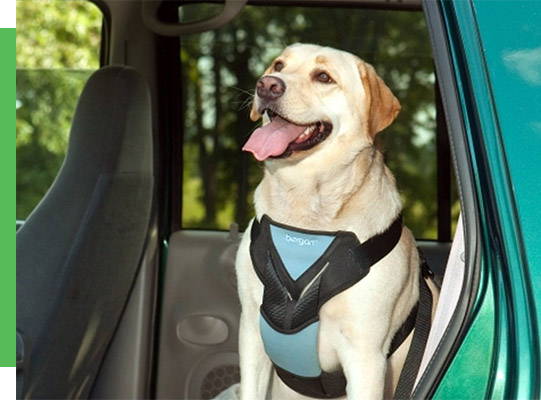
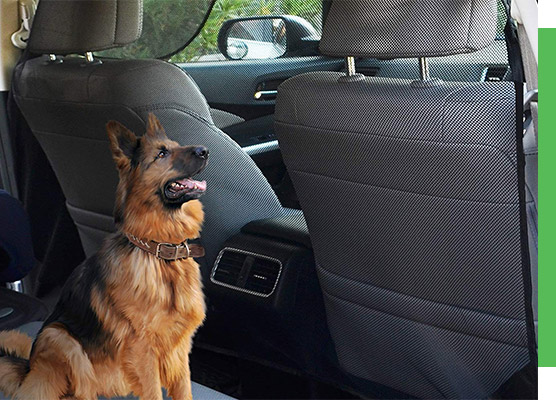
![]()
F FOR A DOG THAT LOVES JUMPING INTO THE FRONT SEAT:FRONT-SEAT BARRIER
Despite how much you love each other, you and your dog are safest when separated by the front seat - even if this requires a literal barrier.
Take note: These barriers are intended to supplement another form of dog restraint, such as a harness or a booster seat.
To use: Remove the headrests from the front seats. Slide the D-rings on the top of the barrier onto the posts of the driver’s and passenger’s headrests. Clip or hook the bottoms of the barrier below the front seats and adjust as needed.
![]()
FOR WINDOW WATCHERS: BOOSTER SEAT
Best for small dogs and calm travelers, the booster seat slightly elevates your dog so that they can fully enjoy the sights and smells beyond the window.
Take note: Booster seats should always be used with a travel harness. Steer clear of booster seats with long tethers that attach to your dog’s collar, as these can cause strangulation.
To use: Place the booster seat on the backseat of your car. Secure your dog in a proper travel harness, which can be attached to the inside of the booster.

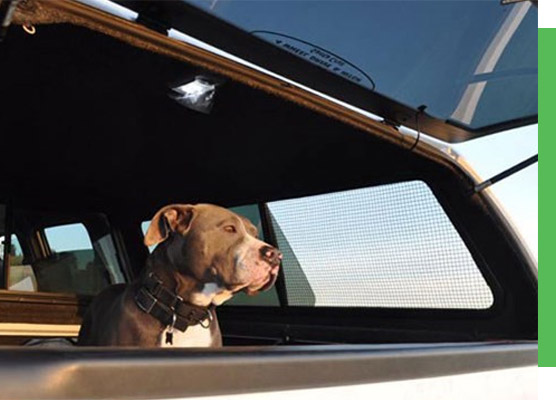
![]()
FOR TRUCK OWNERS: CRATES WITH A TETHERING SYSTEM AND TRUCK SHELL
All too often, you see dogs sliding around in the backs of trucks as their owners speed down fast roads. If the only space for your dog is in the truck bed, take the necessary precautions to maximize their safety.
Take note: A high-quality travel crate should have double-wall construction, guarding against both colder weather and car crashes.
To use: Using a crate in a truck bed is very similar to using a crate in the backseat of your car; however, it is especially important to properly tether the crate into the truck bed to prevent sliding. You can also purchase a truck bed shell and a canopy to shield your dog from road debris, harsh sunlight, and heat, particularly if you are stopping to camp.
Tips and Tricks
![]()
Travel with reusable water bottles so that you can always refill your dog’s water bowl, regardless of how close you are to the nearest rest stop.
![]()
Windows can be cracked slightly, but not so much that your dog’s head can stick out! The wind quickly dries out their eyes, nose and mouth, and flying grit from the road can cause further irritation.
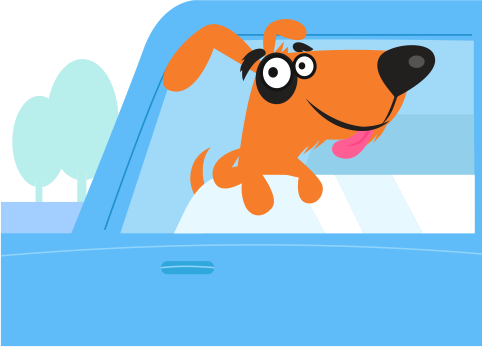
![]()
In the unlikely event of separation during a long road trip, make sure your dog’s collar tag has your contact information. Better yet, consider microchipping your pet to ensure their safety.
![]()
Particularly during long trips, make time to get your dog (and yourself) out of the car and exercise! Breaks for movement will help unleash some of your dog’s pent-up energy, turning their car time into naptime.
![]()
Be careful about what and how much your dog eats on the road - the bumpiness of travel can make them carsick.
![]()
When driving with dogs, it’s always helpful to pack extra towels, stain remover, hand sanitizer, and any other cleaning supplies.
Facts and Figures
Not all dog car restraints are made equal. The car company Subaru formed an alliance with the Center for Pet Safety (CPS) to sponsor crash tests of 29 car pet restraints. Incredibly, 25 of the 29 restraints failed their tests.
![]()
Based on these and other findings, CPS urges pet owners to avoid products with long tethers or zip lines that attach to your dog’s walking harness or collar. These products cannot stop your pet from launching forward in the event of a crash.
![]()
When deciding on a car restraint for you dog, always check to see if the product is certified by the CPS.
Remember: dogs should not ride in the backs of pick-up trucks without being properly secured.
![]()
According to the American Humane Society, an estimated 100,000 dogs die in accidents each year due to riding in truck beds.
Dogs, hot cars and hot pavement are a bad combination! According to the Iowa Veterinary Specialties, a dog can experience brain damage in just 20 minutes due to heat stroke. Watch out for the key signs of heat stroke, including restlessness, racing heart beat, heavy panting, and vomiting. Keep the AC running, and never leave your dog unattended in the car regardless of the outside temperature.
Final Takeaways for Canine Car Safety
Whether a nervous rider, a high-maintenance diva, or an adventurous sidekick, your dog should be treated like any human passenger. When choosing products to maximize your pet’s safety while on the road, be sure to:
Avoid harnesses with “zip lines” or tethers that attach directly to your dog’s collar. These could seriously injure your dog in a car accident, as your dog’s neck is the only connection point to the backseat.
Check both the safety certifications and purchaser reviews of the products you consider.
Match products with your dog’s size, age, and travel temperament.
Although the sheer variety of safety products can be both confusing and intimidating, your goal as a pet owner remains simple: to protect both you and your dog whenever you take to the road. By paying attention to the safety certification and consumer reviews of different safety products, a routine car outing with your dog can become the recreation of an iconic car commercial.
